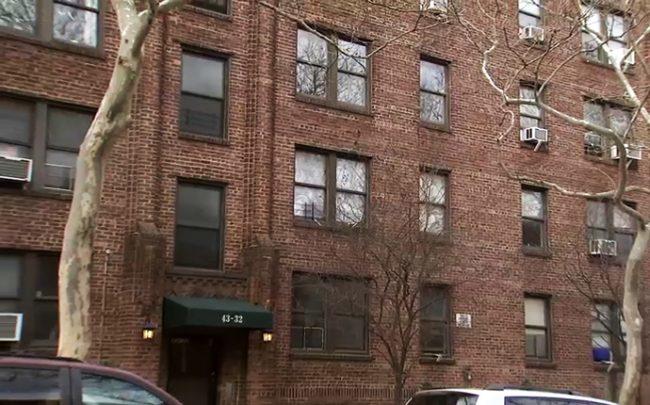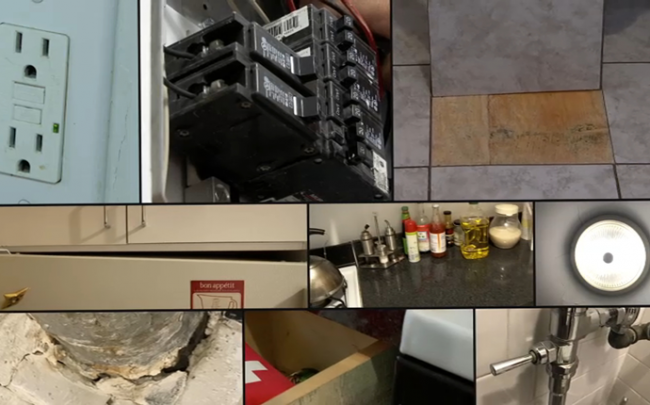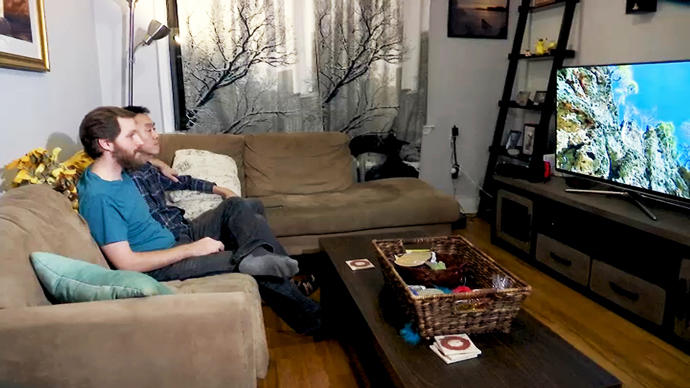When Clem Chan and his husband Matthew Haensly signed the lease for their Sunnyside apartment, they thought the landlord was giving them a deal.
They agreed to pay $2,500 a month — a discount from the $2,800 the landlord could legally charge. But after reading news stories about the abuses associated with rent-stabilized apartments, Chan decided to look into the apartment’s rental history.
For more than two decades, the rent inched up gradually from $800, reaching $933 in 2014. Chan then noticed that two years before they moved in, the unit’s rent increased dramatically — by $1,317 a month. The increase, according to the landlord, was mostly a result of renovations completed in 2014.
“That seemed really suspicious to me because our apartment didn’t look like a palace or anything,” Chan said. After all, the cabinets were crooked and didn’t shut properly, there were problems with the toilet, cracks in the ceiling, and a laminate tile in the middle of the kitchen floor often peeled off from wood underneath.
Chan is one among dozens of tenants across the city suing their landlords over “Individual Apartment Improvements,” or IAIs, which allow building owners to permanently increase the rent on rent-stabilized apartments, calculated as a percentage of the claimed cost of renovation work. While landlords are supposed to keep receipts and other documentation justifying these increases, they are not required to submit them to the state housing regulator for review.

Clem Chan and Matthew Haensly
It’s a program that housing activists and elected officials have long criticized as too easy for landlords to cheat, by either deliberately overspending on low-quality work or not actually making the improvements in the first place.
Chan’s lawsuit accuses his landlord, Bronstein Properties, of committing fraud by misrepresenting the true cost of construction. Bronstein has responded with canceled checks and an invoice, insisting the costs are fully justified.
But some critics, including State Senator Michael Gianaris (D-Astoria), say even absent claims of fraud, IAI renovations are often little more than convenient excuses for landlords to raise the rent with little scrutiny.
“They’re self-certifying the fact that these improvements have taken place and there’s little to no oversight on behalf of the housing agencies in the government that are supposed to represent the people,” said Gianaris, the incoming deputy majority leader. “You see abuses time and time again.”
Now Gianaris and the incoming Democratic majority in the New York State Senate are considering legislation that would eliminate IAIs from rent stabilization laws.
But tenants and politicians aren’t the only ones pointing out regulatory and enforcement issues with the IAI system. In one recent case the accuser is a real estate investor.
Rob Rosania, once an investor in landlord Stellar Management, alleged in court last year that his former business partner, Larry Gluck, “entered into a fraudulent secret arrangement with contractors performing renovations” at buildings in the Upper West Side, in a conspiracy that “inflated the prices charged for the renovations.” A spokesperson for Stellar Management rejected these allegations and said the company acts in accordance with all regulations. The case is still pending in New York Supreme Court.
IAI cases against building owners and managers often come down to he-said-she-said disputes, where building reps insist on the validity of their self-certified costs and tenants claim those costs don’t match the conditions inside their rent-stabilized units.
“If you didn’t do it on the honor system, and you had to go through a procedure with [the state], apartments would sit vacant for months on end,” said Frank Ricci, director of government affairs for the Rent Stabilization Association. “The losers at the end of that are tenants.”
To better understand allegations of improper renovation charges, WNBC and The Real Deal tapped three independent contractors to review work performed at Chan’s apartment in Sunnyside, Queens, where he and his husband accuse landlord Bronstein Properties of overcharging them on rents based on renovation work they say doesn’t match the price tag.
We then compared contractors’ cost estimates at Chan’s apartment to an invoice for the renovation work supplied by the landlord’s attorney. The results highlight the flaws in a system that — even when functioning as designed — is often subjective and puts the responsibility on tenants to determine when and if they are being overcharged.
A second opinion
Chan and Haensly live in an eight-unit walk-up in Queens at 43-32 47th Street. Some of their neighbors are families who have lived in the building for years, and some struggle to pay the rent every month, they said.

43-32 47th Street in Queens
“The family that lived below us had to move out because they couldn’t afford to pay the rent,” said Chan. “Sometimes it’s hard for people to see actual human beings behind the numbers.”
Generally speaking, Chan and Haensly really like their apartment. They feel fortunate to have found a two-bedroom home with enough space for the two of them and their roommate. But once Chan and Haensly learned how much money was spent on fixing it up — and the ensuing rent hike — they wondered if the costs added up.
Unlike many landlords accused of IAI fraud, Bronstein kept the original renovation invoices, including checks, for Chan and Haensly’s apartment. The company’s attorney provided TRD and WNBC with an invoice that shows a contractor charged the landlord $40,325 to improve the bathroom, kitchen and install new electrical components, plus an extra $1,000 for appliances.
WNBC and TRD asked two licensed contractors, a master electrician and a carpenter to evaluate the apartment and provide their own estimates. Each found problems they believed stemmed from poor workmanship, some that Chan and Haensly had not noticed.
Though they all agreed that renovation work had been done, the contractors pointed to a number of defects in the kitchen, including an uneven subfloor beneath the vinyl tiles (some of which were removable) and a lack of outlets along the counter. Stan Dobrzynski, owner of SMD Project Management, called some the work “hazardous,” and pointed to an electrical outlet located directly above the kitchen sink.
“It looks like somebody backed up the pickup truck at Home Depot and just came here with new cabinetry, new counter tops, [and] obviously didn’t care about the electrical, didn’t put any thought whatsoever,” he said. “It’s shoddy workmanship at its best.”
The contractors we contacted couldn’t properly judge some of the work outlined on the invoice, such as new plumbing risers in the bathroom. Doing so would have required demolishing walls to see what was behind them. So for the purposes of the estimate, such improvements were assumed to have been performed properly.

A contractor pulling off kitchen tile
The contractor estimates came to an average of $27,000 — $13,325 less than what’s stated on Bronstein’s invoice. For Chan and Haensly, that could mean a potential $4,000 decrease in yearly rent.
It also appears the electrical work was done without permits. The city’s Department of Buildings requires permits to be issued for the installation of a new circuit breaker, outlets and electrical lines. No such permits appear on record, and contractors we contacted also said the circuit breaker in Chan and Haensly’s apartment did not appear up to code.
The reason no permits were pulled could be because Bronstein’s hired contractor, Bright Light Construction LLC, is not licensed with the city’s Department of Buildings, nor with the city’s Department of Consumer Affairs. Bright Light was also fined by the city’s Business Integrity Commission for “removing trade waste” from a building without a license, documents show.
A representative for Bright Light initially said he couldn’t discuss any work done by the company. He later sent a written statement, saying Bright Light works with several property managers around the city and “Bronstein Properties has no ownership stake in our business whatsoever.” The Bright Light representative added that if any customers are unhappy with the company’s work “we are always happy to do whatever necessary to make it right.”
Aaron Carr, founder of the Housing Rights Initiative, an organization that has initiated several class-action lawsuits against landlords alleging abuse of the IAI program, including Chan and Haensly’s, acknowledged that not every type of renovation needs a permit, but said work that costs tens of thousands of dollars without requiring approvals should raise a red flag, especially when improvements aren’t physically evident.
“We have never seen a building that came with a butler or gold toilet seats or anything of the sort,” he said. “If we did see that, we would tell the tenant you may want to think twice about this, perhaps the landlord did the improvements.”
Bronstein Properties’ attorney, Adam Leitman Bailey, took issue with TRD and WNBC’s methodology. “Relying on an assessment by a contractor without knowledge of either the monetary damage caused by four tenants since 2014, the extent of the 2014 improvements, nor the work required after 22 years of previous occupancy by a single tenant is absurd. Any suggestion that we are making renovations to our properties simply so we can raise the rents is patently false,” he said. Bailey also said that the tenants never complained about apartment defects, and since the time TRD and WNBC first brought their findings to the landlord, it has made repairs.
TimeLine Renovations president Robi Kirsic, who reviewed improvements at Chan’s apartment at our request, noted that the cost for renovation work at a single unit can vary dramatically, even by as much $20,000. That’s largely due to costs of labor and company overhead. But he said sometimes companies cut costs by opting out of hiring licensed professionals – which is required of certain trades.
“You can take one individual that can literally do every single trade, from plumbing to electrical to carpentry to tiles,” he said. “They can do it and perform it, but they are not legally allowed to do it.”
Justin La Mort, a tenant attorney and law professor who has studied the IAI system extensively, said determining what work actually happened in an apartment is often extremely difficult, because the work is typically done during vacancy periods. Tenants who think their rent has been improperly raised have a hard time proving it, he said, even when they complain to the state housing regulator, the Division of Homes and Community Renewal (DHCR).
“Even if you’re completely neutral on this issue it just seems like a terrible incentive structure,” he said.
The way the system was designed
Chan and Haensly feel that they were blindsided by the rules surrounding rent stabilization and apartment improvements. They say they didn’t know that their apartment was rent stabilized until they signed the lease. And if they had waited much longer before requesting their rent history, they wouldn’t be able to complain about the IAIs in the first place: Tenants only have four years from the date of improvements to challenge them.
After pulling the rent history for their two-bedroom apartment and seeing the steep increase just two years before they moved in, Chan contacted Carr. Chan and Haensly joined a 67-plaintiff complaint, which includes tenants who allege that Bronstein systematically inflated the costs of renovations across its Queens portfolio. In some cases, Bronstein is accused of using the renovations to unlawfully deregulate the units while its entities received a tax abatement called J-51.
“I thought a housing agency is there to protect tenants,” Chan said. “By going through this process, it seems like the burden is on the tenant to understand really complicated real estate jargon and laws.”
DHCR does not require landlords to send receipts, nor does it inspect what work was performed except in the cases of tenant complaints. Even then, a full and thorough audit of the work performed is rare, experts said. Building owners aren’t required to show building permits, either. Landlords instead operate on an honor system.
And even when receipts are produced, it’s difficult for the agency to determine what is fair and what is fraudulent. In fact, they often don’t try: As long as landlords performed some version of the stated improvement, DHCR has previously ruled that it doesn’t matter how much they paid.
“There are a couple of cases where they found increases grossly disproportionate,” said Seth Miller, a former legal staffer in DHCR’s enforcement unit and now a tenant attorney. “But in general they will take the landlords word for it.”
In the Bronstein case, the landlord’s attorney, Adam Leitman Bailey, has cited past rulings by DHCR deputy commissioner Woody Pascal in order to reject tenant complaints. In one, a tenant alleged that improvement costs were far higher than what the work performed in their home would have merited. In denying the petition, Pascal cited the rent stabilization code, which does “not require that an owner improve an apartment at the lowest price.”
In a statement, DHCR said it “follows the Legislature-approved rent regulation law when it reviews Individual Apartment Improvements that are among the more than 1,000 tenant-driven overcharge” cases it resolves annually.
The agency also said “the law does not include price controls, leaving owners to make the decisions on the purchases and investments they make for the properties they own.”
Whatever the price of a renovation, DHCR rules clearly state that landlords should retain documentation to justify the cost. At least one audit shows many landlords do not.
In 2012, DHCR’s Tenant Protection Unit decided to audit more than 1,100 IAIs. It found that in as many as 40 percent of those cases landlords were unable to support their stated renovation costs with proper documentation, according to The New York Times. Some owners entered settlement agreements with the TPU.
“That’s a huge number, and when you think about that in terms of a scale of 1 million apartments, that is hundreds of thousands if not millions of dollars that are being stolen from tenants,” La Mort said.
DHCR has not disclosed whether any Bronstein units were among the hundreds without proper documentation.

(Credit: WNBC)
In response to questions about how it is combating false IAIs, a representative for DHCR said that the Office of Rent Administration can send inspectors to apartments when a tenant has filed a complaint and “in instances where there is conflicting information.” The representative did not provide information about how often these kind of inspections are done, nor did they provide any indication as to how many IAI-related complaints are filed annually.
DHCR has not provided any documents that show how much rent-stabilized apartment rents have risen because of IAIs specifically, but the agency did say that 3,700 apartments went through “high-rent vacancy deregulation” in 2017 alone, a process that is often aided by IAI increases.
Miller and critics of DHCR say the agency does not ultimately view itself as the protector of affordable housing stock. “They don’t see any [issue] with units getting large increases and in a step-wise fashion being deregulated,” Miller said. “They don’t look at it as a problem.”
“Part of it is because they’re not funded properly and part of it is the culture of that bureaucracy has been pro landlord in a lot of ways,” said Gianaris. “So when their day to day interaction is with landlords who are self-certifying some of these changes, they have become too cozy with the owners and not protective enough of the tenants.”
The way Gianaris hopes to help DHCR deal with IAIs is to eliminate them. The bill he plans to introduce next year would eliminate the increases as well as a building-wide improvement increase program called Major Capital Improvement, or MCIs.
“Landlords are expected to make improvements on the buildings that are fundamentally their assets, at the end of the day. We shouldn’t have to pass those costs along to the tenants,” he said.
The real estate industry has largely taken the stance that the IAI program provides a necessary incentive for landlords to improve their properties. Without it, landlords and developer groups say renovations would immediately halt.
“I think it’d be a disaster for the New York City housing stock and tenants,” RSA’s Ricci said. “If the senator wants private housing to operate like NYCHA, then it’s a great idea.”
Landlords are expected to make improvements on the buildings that are fundamentally their assets, at the end of the day. We shouldn’t have to pass those costs along to the tenants, he said.
Self-dealing?
Rob Rosania, who formerly partnered with landlord Stellar Management, declined to speak on the record for this story, but his public allegations of “fraudulent” contractor arrangements align with research undertaken by Carr’s HRI. The group’s research has attempted to establish inside relationships between landlords and the contractors they employ for apartment improvements. For example, in several cases, HRI has found contractors who only appear to file permits for a single landlord.
One contractor used by Stellar, MJA Associates, has a publicly listed telephone number that is the same as Stellar’s and in many permit filings its listed contact person is now former Stellar employee Stacey Ruggeri, who was Stellar’s vice president of construction and development. According to HRI’s review, almost all of the projects MJA has filed permits for are in Stellar’s buildings.
Rosania alleged that corrupt contractor relationships were used to mark up the costs of apartment improvements by $40,000 in the two buildings he invested in. That would allow for up to an additional $667 per month in apartment rent increases per unit, based on the increase formula provided by current laws.
The allegation resembles a scheme the New York Times reported on this year relating to the Trump family, which, according to the Times, routinely increased rents based on inflating the cost of building-wide improvements, such as new boilers, to the tune of $30 million over several decades.
In response to the Times report, an attorney for President Trump called the fraud allegations “100 percent false, and highly defamatory.”
This is not the first time Stellar has dealt with IAI allegations: In 2005, Stellar and partner Chetrit Group settled IAI allegations through DHCR for the Park West Village apartments, where tenants hired engineers to evaluate apartment improvement costs they thought were unfair. “The tenants agreed that the particulars of their individual settlements would not be made public and that fraud would not be charged,” according to a 2008 article in the Park West Tenant Newsletter.
Stellar declined to answer questions about the report of a settlement Park West Village tenants.
I think it’d be a disaster for the New York City housing stock and tenants, RSA’s Ricci said. If the senator wants private housing to operate like NYCHA, then it’s a great idea.
Dozens of tenants, organized by Carr, are now suing Stellar over improvement costs at buildings across the city. Carr believes that when shell companies are effectively controlled by the landlord and paid for renovation work, it is fraud. That “fraud,” he says, is “ubiquitous.”
In the current lawsuit with Stellar, however, establishing such a relationship may prove difficult. For most of the apartments involved in the litigation, no building permits were filed, meaning information about the contractor Stellar used is not in the public record.
As with the lawsuit filed by Rosania, a spokesperson for Stellar responded to the HRI suit saying the company always acts lawfully and rejects allegations of improper IAI renovations.
Since 2016, DHCR has said that in cases where a contractor is determined to be closely tied to the landlord it “may” require additional documentation to verify that the payments are real, if and when, of course, tenants know to request them or if DHCR asks for them after a tenant complains.
Both Bronstein and Bright Light insist they are entirely separate entities. But for Chan and Haensly it makes little difference who completes an IAI renovation or how it is accounted for. The impact of an expensive construction job is the same for tenants, no matter who does the work. The result for landlords is a higher rent, and a chance to inch closer to deregulation.
“That’s their goal,” said Haensly. “They want somebody to move in with this preferential rent, and then whenever they can charge that extra couple hundred of dollars when our lease is up, they’ll pull it and they’ll charge us the full amount. It’s this whole game these that guys are playing. They know that people don’t know any better.”
Correction: An earlier version of this article misquoted Rob Rosania’s lawsuit




